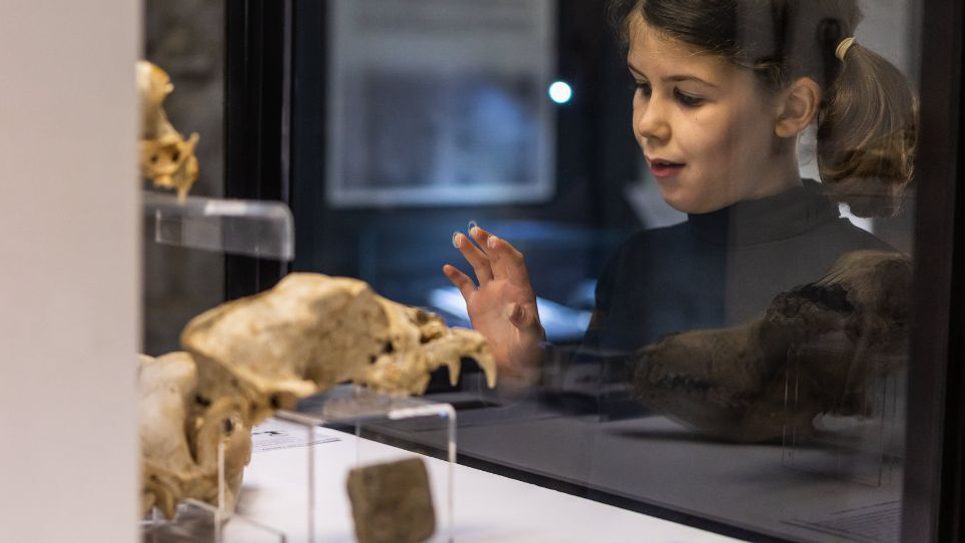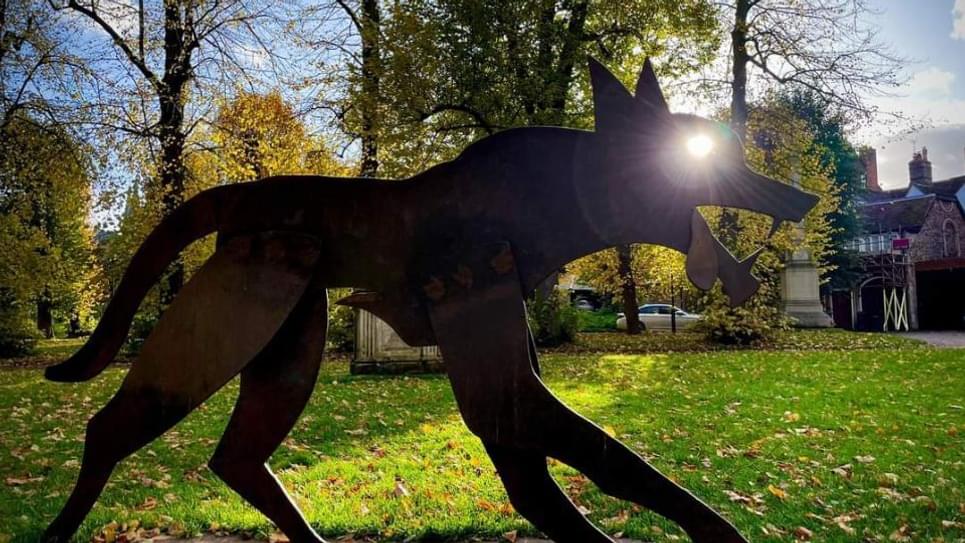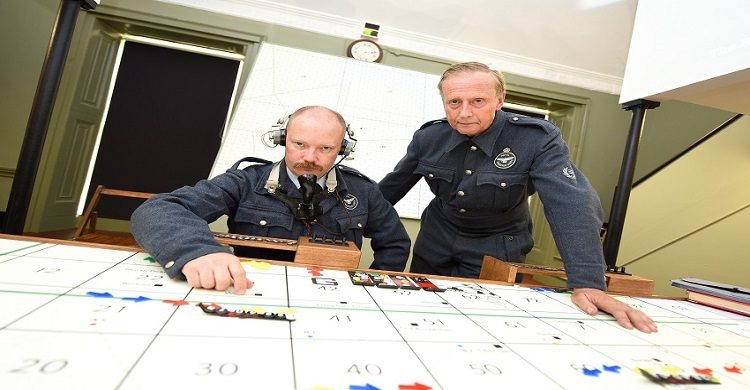
Back to Blogs
Discover
The Mysterious ‘Wolf’ Burial at the Abbey of St Edmund
The wolf skulls in the Moyse's Hall Museum's collection continue to be some of the most popular artefacts for staff and visitors alike and their significance a matter of great debate and several theories.
Dan Clarke, the Museum's Heritage Officer, outlines the theories.
Pets, Trophies or the Guardians of the Abbey?

The Norman Tower at night. Photo: Phil Morley
In the 1840s, workmen, trying to alleviate drainage issues around the Norman Tower at Bury St Edmunds, began to dig down to medieval street level. To this day the impressive tower sits within the trench they created. The workmen discovered “about 20” animal skulls nine feet away from the towers wall, in the direction of St James’ Church, now the Cathedral.
According to contemporary reports, the skulls were sent to Professor Richard Owen of the Royal College of Surgeons, perhaps best known for coining the word ‘dinosaur’, who reported back: “they are all of the Wolf, with the exception of one skull, which is of a large Dog.” It’s worth noting that Professor Owen is considered a bit of a charlatan, famed for wild theories and assertions.
Differentiating between wolves and dogs is still problematic to this day, as I recently found when seeking scientific assistance in definitively identifying the skulls. Both visually and through forensic analysis, the animals are too closely related to give definitive answers. A further issue being the long-term handling and display of the objects, both of which hindering the organic make-up of the specimens. Thus, part of the mystery remains whether they are dogs, wolves, or a collection comprising both. Only three intact skulls remain within the museum service.

Theory 1

Photo: Dan Clarke
A local hunter, owing money to the Abbey, settled debts by killing wolves (pests).
Or perhaps a celebrated hunting hound of the Abbey buried with his trophy kills. But considering the prime location next to the VIP entrance to one of the great Christian sites this seems unlikely.
Theory 2

Photo: Dan Clarke
Some dogs were incredibly well treated within abbeys/priories. Maybe this is a pet cemetery. 80s horror fans calm down! Why would you sever the heads of a beloved pet!
Theory 3

The wolf guarding St Edmund in The Great Churchyard
Maybe former guard dogs of the Norman Tower still keeping watch?
Cute, but unlikely. And again, why only the skulls?
Theory 4

Sculpture of the wolf in the Abbey Gardens by Luke Williams
My personal favourite and suggestion. There is an interesting site at Cheia, Romania, where a grave was being excavated. The grave was desecrated by robbers almost contemporaneous to its creation 2000 years ago. Thieves, it seems to archaeologists, placed an assumed wolf skull on a pile of stones facing into the circular gravesite.
It is believed that the wolf (or dog) was meant to stop the rising dead seeking revenge.
This doesn’t fit perfectly to our Christian site, but it does lead you consider protection/guarding.
The pose of our skulls at Bury St Edmunds was not reported, but their direction would have been interesting – perhaps they guard the sleeping souls within the Abbey, or symbolically protect the gate against the evil outside. East Anglia is no stranger to ritual deposits, nor was the rest of England, with the post-medieval period seeing animal remains placed in walls, within hearths, and under floorboards; cats perhaps the most infamous. Many ritual deposits and protective curses, like Bartmann (aka Bellarmine) jugs filled with the assumed ingredients of charms, were placed near or at the entrance of buildings to protect from spiritual attacks from outside. The location for our skulls makes more sense if we consider this context, and both wolf and hound have been symbols of protection, and/or threat, throughout history. Locally, this also fits with King Edmund’s severed head being ‘guarded’ by a wolf in his own legend; though if true let’s be honest that’s lunch not loyalty!
The wolf as a symbol might seem problematic in history. A pest hunted to extinction in medieval England, yet frequently appears within heraldry of the time as symbolic of courageous endeavour, perseverance in long sieges, and hard work. Medieval depictions of dogs could symbolise protection, loyalty, faithfulness, alertness; with hounds also used as a display of good knightly values and chivalry. To a certain extent, whether great or small, these ideas of protection and alertness at the main gate of our fortified Abbey seem a better, if perhaps not perfect, fit for our study.
The Debate Continues

Photo: Jo Sweetman
All speculative, but the debate has been ongoing since their 1846 discovery, and Professor Owen’s 1848 suggestion. The skulls continue to be some of the most popular artefacts for our staff and visitors alike. The debate rages on!
To find out more about Bury St Edmunds horrible histories follow The Grotty Curator on Instagram.
Related Blogs

News
Bury Tour Guides to launch…
Bury St Edmunds Tour Guides to Introduce new tours in…

News
Town’s Museum Forms New…
Moyse’s Hall Museum will be forging links with a…

News
St Edmundsbury Cathedral…
St Edmundsbury Cathedral in Bury St Edmunds is…

News
Bury St Edmunds & Beyond…
Step inside many of Bury St Edmunds historic buildings…

News
Bury's Best Pubs with a Past
some notable, historic and somewhat quirky pubs and…
Latest news

News
How to Spend Betwixtmas in Bury St Edmunds & Beyond
The post Christmas period is the perfect time to get out and about before the new year kicks in, and you’ll find plenty of activities and places to visit in Bury St Edmunds and beyond.

News
Parents Guide to Pre Christmas Entertainment
It's the school holidays and with Christmas just around the corner we've put toegther a guide on places to take the kids to keep them entertained until Santa visits!

News
Enjoy a Festive Afternoon Tea in 2025
Celebrate the Christmas season with a festive afternoon tea in Bury St Edmunds & Beyond...

News
Festive Winter Walks
Get outside and enjoy the fresh crisp winter air with one of these walks in Bury St Edmunds and Beyond!

News
Bury Tour Guides to launch new tours next year after successful 2025
Bury St Edmunds Tour Guides to Introduce new tours in 2026 and continue the successful Food and Drink Tours!

News
New in Bury St Edmunds For 2026
A sneak peak into new attractions visitors can enjoy in Bury St Edmunds in 2026.

News
Baby It's Cold Outside... Things To Do When the Weather Turns Frosty
Just because the temperature’s dropped doesn’t mean the fun has to! If you’re visiting town during the chillier months, there’s still plenty to see, do, and experience.

News
Places to sit by a roaring fire in Bury St Edmunds & Beyond
Warm up by a roaring fire this winter in Bury St Edmunds & Beyond...

News
Christmas Park and Walk 2025
Additional parking has been provided by West Suffolk Council in partnership with Greene King this Christmas.
